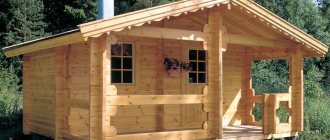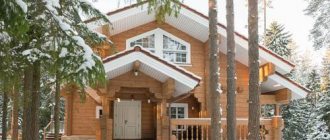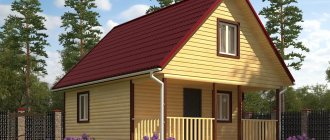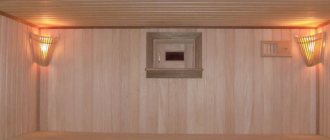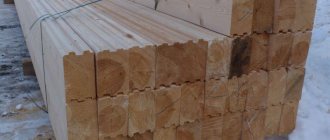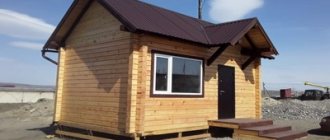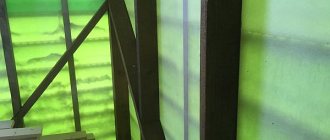Owners of houses and bathhouses whose buildings are built from laminated veneer lumber note the following fact: performance characteristics directly depend on the quality of the material used for construction. And this position is completely justified, since its production requires strict adherence to all stages of the technological process. If the production has an underdeveloped infrastructure and is aimed only at obtaining high profits, then there is a high probability that the produced material will be of rather low quality. Therefore, it is unlikely to meet all GOST requirements for construction products.
Possible disadvantages
Analyzing reviews of bathhouses made of laminated veneer lumber, we can draw a very specific conclusion that the main disadvantage of all buildings lies precisely in the use of handicraft material for construction, with all the ensuing consequences.
The log house shrinks more than was stated by its manufacturer. This point is associated with the discrepancy between the moisture content of the material and the standards for wooden construction, which should range from 8 to 18%, depending on the glue used and the type of timber. The level of material shrinkage under such conditions is 1 – 2%.
The appearance of a large number of cracks is also related to insufficient drying of the component parts: lamellas or the use of an adhesive composition to connect them, the cost of which is insignificant. As a result, the lamellas begin to dry out and crack, which, in turn, leads to a deterioration in the general properties of the material, such as heat and sound insulation.
A sauna made of laminated veneer lumber does not allow air to pass through (does not “breathe”), but instead emits fumes that are harmful to health. This is true, especially in cases where the manufacturer, saving on more expensive and environmentally friendly glue, uses adhesives that make it possible to build technical structures in the form of warehouses from this timber.
Positive about profiled baths
If the material or bath set was ordered from a company that values its reputation, then the reviews will be good and correspond to the stated advantages:
- Construction is more economical than using other high-quality materials. (Review from Sergei Mikhailov from Kazan: “We spent a long time deciding what to build a bathhouse from. Brick was expensive, we calculated a rounded log and were also disappointed. In addition, finishing and insulation added to the additional costs. Specialists from a local company suggested to us the option of a bathhouse made from profiled timber. Project We assembled it ourselves from a ready-made kit. My son and I also made the foundation. It turned out cheap and pretty quickly.")
[ads1]Assembly does not require additional equipment and can be done in the shortest possible time. (Our plot is not large. Everything is planted and built up. We thought that it was impossible to build a bathhouse. It turned out that we could make a lightweight pillar foundation and take light material - profiled timber. We purchased a cross-section of 100x100. We worked together with our son. The bathhouse was built in three weeks together with drainage and interior."- No additional wall finishing required. (Nikolai Mikhailovich Moscow: “I entered into an agreement with a developer company for a turnkey bathhouse.” They came and measured everything completely free of charge. The material was inexpensive. They built everything in 14 days. With my direct supervision. I specially inspected the walls, not a single crack. And I saved a lot on insulation. A bathhouse made of profiled timber is suitable for economical owners.")
- Warm and environmentally friendly. (Vasilisa Stepanovna, Surgut: “They decided to immediately build the bathhouse from profiled timber. This material is more environmentally friendly compared to laminated veneer lumber. For the walls, they chose a section of 150x150 chamber drying. The bathhouse practically did not shrink. The walls are smooth and beautiful. You can heat it in 2 hours to 900C" .
- Minimal shrinkage during chamber drying. (Victoria, Ulyanovsk: “I specially measure the shrinkage of a chamber-drying bathhouse made of profiled timber. Losses are minimal. The seams have not come apart. This is the second year we’ve been using them, I recommend these bathhouses to everyone.”
Positive aspects of construction
However, not all reviews about saunas made of laminated veneer lumber carry a negative charge. True, this mainly applies to those buildings that were erected from materials from companies that have a certificate of compliance with technical production conditions. This fact certainly allows such developers to compete widely in the construction market.
But their average prices for finished high-quality products are higher than average, so construction products are not available to every consumer.
Thus, the minimum turnkey price for a bathhouse made of certified material with a wall thickness of 100 mm, without a foundation, with an area of 13.4 sq. m will be somewhere around 200 - 220 thousand rubles.
Despite the somewhat high cost, the construction of a structure from such material provides certain guarantees, which are confirmed not only by manufacturers, but also by the owners of such buildings:
The walls of the sauna room retain heat perfectly, prolonging the ability to steam for a long time without additional fuel, which reduces its consumption.
Possessing high strength, laminated veneer lumber allows the construction of two-story baths without fear of severe shrinkage and the possibility of its speedy commissioning. In addition, in order to save money, you can always select a building option with an attic, which has the area of a two-story bathhouse, but at a lower price.
The durability of the buildings was declared by modern architects, who used laminated veneer lumber in the construction of such landmarks as the Sibelius House concert hall in Finland, as well as in the reconstruction of the cathedral on Trinity Square in St. Petersburg.
Creating a favorable indoor microclimate is only possible when using water-based glue without adding harmful resins, which can only be confirmed by the above-mentioned certificate.
It has been noticed that high-quality laminated wood is not susceptible to cracking, thanks to careful drying and discarding of the lamellas. Of course, under the influence of sunlight and temperature changes, the appearance of small cracks will be inevitable. This will not have such a strong impact on the appearance of the building, much less on the protective functions of the material. In this case, sticking of the lamellas is absolutely excluded.
As many years of experience show, the prospect for the development of construction from laminated veneer lumber has a very positive trend, since improving the qualities of wood, unique in its properties, will certainly lead to an increase in its demand.
What is profiled timber?
Profiled timber is a building material obtained by mechanical processing of wood. Most often, pine, spruce, cedar or larch are used for its production. The final cost of the product depends on the type of wood.
The front side can be flat, which is most common, but it can also be rounded. It is less common to find another configuration. A tongue-and-groove fastening system is milled on the upper and lower planes, ensuring a reliable connection of the beams to each other.
At the first stage of production, the log is unraveled onto a carriage. The resulting workpiece is sawn in accordance with the specified dimensions, after which tenons and grooves are selected.
Manufacturer reviews
As a rule, manufacturers of this material try to hide negative reviews due to the fact that the product they sell should be characterized only on the positive side. However, alas, this is not always the case, and truly reliable information can only be obtained by visiting one or another construction forum. And to make it easier to navigate, we will try to combine this information in one material.
Mold and mildew in the bathhouse
The “weak point” of wood is that it is susceptible to rotting and the appearance of fungus, even after treatment with protective compounds. Finding good construction wood is extremely difficult, especially in the Urals. Our region is rich in forests, but the quality of local wood is not suitable for the production of building materials. In addition, the wood is often not dried as necessary.
Twinblock does not contain organic substances, so walls made from it are not subject to the destructive effects of microorganisms. This is a guaranteed high-quality, certified material that provides predictable results. If the construction technology is followed (more on this below), a bathhouse made of aerated concrete will last for decades and will not become moldy or rot.
Advantages of laminated veneer lumber
So, here are some positive reviews about laminated timber baths from various forums:
- The structure made of timber has good thermal insulation of the walls thanks to a special profile texture, which allows the joining of logs without gaps. Inserted groove into groove, such a connection protects against the formation of cracks in the wall even after the building shrinks.
- Another advantage is the strength of this material. The increase in strength occurs due to the fact that when gluing the lamellas, the timber is pressed, and this in turn improves its quality characteristics.
- The construction of the structure takes place in a fairly short period of time, since the material has a certain shape, which greatly simplifies the construction process.
- The durability of the building is due to the fact that the timber is subjected to additional processing which protects it from the adverse influence of the external environment.
- The environmental friendliness of the material corresponds to any other lumber, which allows it to be used for the construction of not only houses, but also bathhouses.
- It has good fire safety due to the same impregnation, which increases its resistance to fire.
- Reduced cracking due to pre-drying and pressing during gluing.
Reviews of timber baths on official websites
The high quality declared by the development companies is confirmed by the huge number of reviews from their clients on official websites. But think about why there are so many positive reviews and not a single negative one? Of course, the vast majority of reviews are generated by employees themselves.
Naturally, you shouldn’t paint everyone with the same brush, but we still recommend being wary if there is not a single negative review from customers. Before believing positive reviews, it is better to pay attention to whether the site offers videos or photos of ready-made baths.
A company that monitors its reputation invites clients not only to read reviews, but also to personally go to the construction site, talk to the owners, and see everything with their own eyes. However, the bulk of the reviews that you read on official websites are aimed only at attracting the attention of the consumer, nothing more.
Disadvantages of the material
However, despite all the positive reviews, almost every one of them has its own negative side and they are, as a rule, due to unscrupulous manufacturers seeking to enrich themselves through the use of low-quality composite materials.
You can verify this by reading the following opinions.
- When building a bathhouse or other permanent structure for year-round use, additional insulation may be required. This in turn will hide the original appearance of the building under a layer of thermal insulation.
- When purchasing timber, the buyer cannot determine what quality of wood was used for the lamellas inside the log, which can lead to deformation of the entire structure.
- Simplifying the construction process only makes sense if you do it yourself. For the developer’s company, this nuance is not of particular importance and does not in any way affect the cost of construction.
- Judgments about the durability of buildings made from this type of material are somewhat exaggerated, since it appeared on the market relatively recently and does not have a sufficient service life.
- Unfortunately, the environmental component also remains in question, because high-quality branded glue is quite expensive. Manufacturers often, in order to save money, use not the most environmentally friendly product and such a structure, especially one built from handicraft material, can even be toxic.
- The same applies to fire safety; cheap and low-quality impregnation used for these purposes can also be very toxic.
- The formation of cracks may also be questionable, especially for timber produced in artisanal conditions and without appropriate technologies. The main flaws in the wood can be seen in the following photo.
Which sauna warms up faster and retains heat better?
The ideal material for a bath should provide quick heating of the room and long-term heat retention. The final result depends on:
- thermal conductivity - the ability of a material to conduct heat;
- heat capacity - it affects the thermal insulation characteristics of the building;
- heat absorption - the ability of a material to perceive and absorb heat in contact with other materials.
In all these characteristics, the gas block is many times superior to wood (pine, spruce).
The thermal conductivity of Twinblock D400 (this type of block is most suitable for individual construction) is 0.106 W/m ºС, and that of coniferous wood is 0.180 W/m ºС. That is, the wood is more than 1.5 times “colder” than Twinblock D400.
In terms of heat capacity, the gas block (Twinblock D400) also wins: 0.8 kJ/(kg ºС) versus 2.3 kJ/(kg ºС) for wood.
According to the level of heat absorption: 2 W/m ºС - Twinblock D400, versus 4 W/m ºС - wood. These numbers mean that a wall made of an aerated concrete block warms up 2 times faster than a wooden wall.
Thus, a bathhouse made of aerated concrete warms up faster and retains heat better than a wooden one. This means you will spend less time and resources, i.e. money to heat it.
Fire resistance of bath walls
We will not claim that aerated concrete is an absolutely fire-resistant material. Such building materials simply do not exist. However, a Twinblock wall retains its integrity, load-bearing capacity and thermal insulation properties when exposed to open fire for 3.5 hours! This is confirmed by a fire certificate.
Now imagine what a log sauna will turn into after 3.5 hours of burning? To ashes and much earlier. The walls of the bathhouse made of aerated concrete will withstand, and after a fire the bathhouse can be restored.
Turnkey sauna, price?
When choosing a material for a bathhouse, “price” is the main and determining factor, all other things being equal.
Here is an approximate estimate for materials for the “box” of the bathhouse: Option 1 bathhouse made of aerated concrete (the parameters of the bathhouse are the same as in the previous example)
- Twin block D400 200 mm thick, 8 cu. m. Price - about 30,000 rubles. with delivery;
- Mineral glue for Twinblock, 8 bags. Price – about 2,500 rubles;
- Several bars of F8 reinforcement
Result: 35,000 – 40,000 rubles. for materials for aerated concrete baths.
Option 2 bathhouse made of timber 150 x 150 mm.
- Timber, about 7 cubic meters. m., price – from 7,000 rub. per cubic meter m., i.e. about 50,000 rubles. excluding delivery;
- Tow, 2,000 – 5,000 rubles;
- Pins, 2,000 rub.
Result: 60,000 rub. for materials for a bathhouse made of timber.
Thus, the materials for a wooden bathhouse “box” will cost 1.5 times more than for a bathhouse “box” made of Twinblock D400. It is important that at a lower cost, the walls of a bathhouse made of Twinblock D400 will also be almost 3 times warmer!

